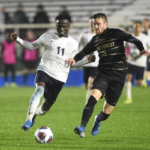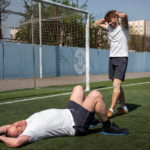Soccer, known as football outside the United States, is a universally beloved sport that captivates millions around the globe. But what does it really take to play this beautiful game? Whether you’re a total newbie aiming to kick off your soccer journey or a seasoned player looking to refine your equipment list, this guide will walk you through the essentials. Discover the key ingredients needed to play soccer and why each piece plays a pivotal role in the game. Stay tuned to elevate your soccer experience!
Essential Soccer Equipment
Playing soccer, known as football outside of the United States, requires not only skill and passion but also the right equipment. The beauty of soccer lies in its simplicity and the minimal gear needed to play. However, the essential soccer equipment plays a crucial role in both enhancing a player’s performance and ensuring safety on the field. Whether you are a beginner or a seasoned player, understanding and acquiring the correct equipment is fundamental.
First and foremost, a soccer ball is at the heart of the game. Various sizes are available, catering to different age groups. For example, size 3 is recommended for young children, while adults use a size 5 ball. Next, every player requires a pair of cleats. These specialized shoes have studs on the bottom to provide traction on grass and help prevent injuries. It’s important to choose cleats that are comfortable and suitable for the surface you’ll be playing on, such as firm ground, soft ground, or artificial turf.
Another key piece of equipment is the soccer uniform, which typically consists of a jersey, shorts, and socks. The uniform is not only a team’s identity but also designed to keep players cool and comfortable throughout the match. Shin guards are also essential, offering protection against potential injuries during tackles. Lastly, for goalkeepers, gloves are a must-have to enhance grip and protect their hands.
While the equipment mentioned above is fundamental, players often use additional gear for training and personal development. This includes items like cones for agility drills, a net for practicing shots, and a medicine ball for strength training. Remember, the right equipment can significantly impact your game, providing comfort, safety, and the confidence to perform at your best.
| Equipment | Description | Age Group |
|---|---|---|
| Soccer Ball | Central to the game, available in various sizes. | Size 3 (Children), Size 4 (Youth), Size 5 (Adults) |
| Cleats | Shoes with studs for traction on different playing surfaces. | All ages |
| Soccer Uniform | Consists of jersey, shorts, and socks for team identity and comfort. | All ages |
| Shin Guards | Protects against injuries during physical tackles. | All ages |
| Goalkeeper Gloves | Enhances grip and hand protection for goalkeepers. | Goalkeepers only |
The essential soccer equipment plays a pivotal role not just in the execution of the game but in safeguarding the players. Adhering to the equipment standards ensures an equal playing field and promotes fair play. For anyone looking to start or continue their soccer journey, investing in quality soccer gear is indispensable. Not only does it prepare one for the physical demands of the sport, but it also instills a sense of professionalism and dedication to the game. As the sport continues to grow globally, the importance of the right equipment cannot be overstated, making it a fundamental aspect of soccer’s enduring appeal and accessibility.
When selecting soccer equipment, it’s essential to consider factors such as quality, fit, and the specific requirements of your league or soccer association. High-quality equipment might come with a higher price tag, but it often offers better durability and performance, potentially preventing injuries and improving your game experience. Always ensure that your gear meets the standards set by your soccer organization to avoid any issues during official matches. By equipping yourself properly, you’re setting the stage for success, safety, and enjoyment in the beautiful game of soccer.
Essentials Unveiled: What Do You Need to Play Soccer?
Soccer, known as football outside of North America, is a globally beloved sport that requires minimal equipment to get started, making it accessible to many. However, to play the game effectively and safely, there are a few essentials that one must have. The most obvious requirement is a soccer ball, which is the heart of the game. The size of the ball may vary depending on the age group of the players. For instance, sizes range from 3 for young children to the standard size 5 for players aged 12 and older.
Next in importance are the soccer cleats. These special shoes are designed to provide maximum grip on the playing surface, allowing players to change direction quickly and reduce the risk of slipping. Cleats come in various styles suitable for different playing surfaces, such as grass, artificial turf, or indoor surfaces. Shin guards are also crucial for player safety, offering protection against injuries from tackles or accidental kicks. These guards should be chosen based on the player’s height to ensure proper coverage and protection.
Lastly, appropriate clothing is essential for both comfort and performance on the field. This includes shorts, socks, and a jersey. The materials should be lightweight and breathable to keep the player cool and dry. Goalkeepers will also need gloves to improve their grip on the ball and protect their hands during the game. With these basic items, any player is well-equipped to enjoy and participate in the beautiful game of soccer.
Quick Guide: Soccer Equipment Essentials
| Item | Description | Notes |
|---|---|---|
| Soccer Ball | Central to the game, available in various sizes | Size 5 for ages 12+ |
| Soccer Cleats | Shoes designed for grip on playing surfaces | Varying styles for different surfaces |
| Shin Guards | Protective gear for the lower legs | Choose based on player height |
| Goalkeeper Gloves | Gloves to enhance grip and protect hands | Essential for goalkeepers |
| Appropriate Clothing | Includes shorts, socks, and a jersey | Lightweight and breathable materials |
Basic Soccer Apparel
The foundation of any soccer player’s gear is their apparel, which combines both functionality and regulation standards. At the core, a player’s uniform consists of a jersey, shorts, socks, shin guards, and appropriate footwear. The jersey is usually lightweight and made of breathable material, allowing players to remain cool and agile throughout the game. Shorts follow a similar design ethos, offering freedom of movement while maintaining modesty and protection.
Shin guards are a critical piece of equipment, providing protection against potential injuries during play. They should fit snugly and be covered entirely by the player’s socks, which not only help to hold the shin guards in place but also contribute to the team’s uniform look. Soccer cleats or boots are specially designed footwear that enhances traction and stability on the playing field, tailored to different types of playing surfaces such as grass, artificial turf, or indoor arenas.
Moreover, while not always mandatory, gloves are essential for goalkeepers, offering grip and protection. It’s also common for players to wear additional gear under their official uniform for comfort or protection, such as compression shorts or shirts, although this should not interfere with the team’s colors or numbers visibility.
Ensuring Comfort and Safety in Soccer Apparel
Choosing the right soccer apparel goes beyond just the aesthetic appeal; it’s about ensuring maximum comfort, flexibility, and safety on the field. Players should select gear that fits well, supports swift movements, and provides adequate protection against the physical demands of the game. This selection process is crucial for optimizing performance and preventing injuries, making it an integral part of a player’s preparation.
| Item | Description | Importance |
|---|---|---|
| Jersey | Lightweight and breathable | Essential for team identity |
| Shorts | Freedom of movement | Comfort and modesty |
| Socks | Supports shin guards | Safety and uniformity |
| Shin Guards | Protection for shins | Prevents injuries |
| Soccer Cleats | Enhances traction | Performance on field |
Types of Soccer Balls
Choosing the right type of soccer ball is essential for the game. The construction, material, and size of the ball can significantly affect how it moves and feels during play. Primarily, there are three main types of soccer balls: match balls, training balls, and mini balls. Match balls are designed for professional play, meeting the official size and weight requirements set by FIFA. They are made with high-quality materials to ensure durability, consistent performance, and accurate flight. Training balls, on the other hand, are built to withstand the rigors of regular practice sessions. They are typically more durable than match balls but may not offer the same level of performance. Mini balls, often used for skills training or recreational play, are smaller and lighter, making them ideal for young players or for honing specific techniques.
The choice of ball can also depend on the playing surface. For instance, there are specific designs for indoor, turf, and hard ground play. Indoor balls have a felt-like surface to reduce bounce and glide smoothly over flat indoor pitches. Turf balls are designed to perform well on artificial surfaces, while hard ground balls are made to endure abrasive surfaces without losing their shape or bounce. Understanding the nuances of each type and selecting the right one for your playing conditions can greatly enhance your soccer experience.
Comparing Soccer Ball Types
| Type | Primary Use | Characteristics |
|---|---|---|
| Match Balls | Professional matches | High-quality materials, FIFA-approved size and weight |
| Training Balls | Practice sessions | Durable, may vary in weight and size |
| Mini Balls | Skills training, recreational play | Smaller, lighter, ideal for young players |
| Indoor Balls | Indoor soccer | Low bounce, felt-like surface |
| Turf Balls | Artificial surfaces | Designed for performance on turf |
In addition to these categories, it’s important to consider the size and age recommendations when selecting a soccer ball. Sizes range from 1 to 5, with size 5 being the standard for players aged 12 and older. Younger players benefit from smaller sizes, as these balls are easier to handle and control, facilitating skill development. Whether you’re participating in a competitive match, practicing for improvement, or playing casually, choosing the appropriate soccer ball is a fundamental step towards enjoying the beautiful game.
Necessary Protective Gear
In the realm of soccer, the right protective gear is not just an accessory, but a necessity. Ensuring player safety allows for the game’s true spirit to shine through—where skill, strategy, and athleticism take center stage. Among the essential items, shin guards stand out as a must-have. These protect one of the most vulnerable parts of a player’s body from inadvertent kicks and collisions.
Equally important is the choice of footwear. Soccer cleats are designed to provide optimal traction on the pitch, reducing the risk of slips and falls that can lead to injuries. However, it’s crucial that these cleats are fitted properly to avoid blisters and discomfort. For goalkeepers, gloves are indispensable. Not only do they enhance grip, but they also offer protection against the high-impact shots goalies face regularly.
Lastly, while not mandatory, the use of mouthguards is gaining popularity. They provide an added layer of safety, guarding against dental injuries during the game’s intense moments. Together, these pieces of gear ensure that players can perform at their best, minimizing the risk of injury.
Further Insights Into Protective Gear
Delving deeper into the significance of protective gear, it becomes evident that beyond physical protection, there’s a psychological aspect. Wearing the right gear can instill a sense of confidence in players, knowing they are safeguarded allows them to focus fully on the game. This is particularly crucial for young players who are still learning to navigate the physical demands and risks of the sport.
Understanding the Role of Protective Gear in Player Development
A closer examination reveals that protective gear is not only about safety but also plays a pivotal role in player development. By reducing the fear of injury, players, especially novices, are likely to take more risks, experiment with new techniques, and engage more fully in practice sessions. This adventurous approach to learning and playing can significantly accelerate a player’s growth and proficiency in soccer.
| Item | Importance | Recommended For |
|---|---|---|
| Shin Guards | Protection against injuries | All players |
| Soccer Cleats | Enhanced traction on the field | All players |
| Goalkeeper Gloves | Improved grip and hand protection | Goalkeepers |
| Mouthguards | Protection against dental injuries | Optional for all players |
| Compression Shorts | Support and muscle protection | Optional for all players |
In summary, the importance of protective gear in soccer cannot be overstated. It not only safeguards the players, allowing them to enjoy the game, but also plays a crucial role in their development and confidence on the field. Whether a beginner or a seasoned pro, the right gear is key to both safety and success in soccer.
Appropriate Footwear Choices
Choosing the right footwear is crucial for any soccer player, whether amateur or professional. The right shoes not only enhance performance but also minimize the risk of injuries. Soccer cleats, known for their distinctive low-cut design and spikes on the bottom, provide the necessary grip on the field, which is essential for quick turns, sprints, and stops. However, the selection of cleats should be made based on the type of surface you’ll be playing on—firm ground, soft ground, artificial turf, or indoors.
For players who frequently play on firm, natural grass fields, firm ground cleats are the most suitable choice. These shoes feature molded studs or blades designed to provide optimal traction and stability. On softer terrains, soft ground cleats, which come with removable studs, allow players to adjust their shoes according to the field conditions. For artificial turf, specialized shoes with shorter studs are available to cater to the unique needs of these surfaces, reducing the risk of injuries that can occur when the footwear grips the turf too aggressively. Indoor soccer shoes, on the other hand, have a flat outsole, ideal for flat, hard surfaces, offering maximum surface contact and grip.
While performance is key, comfort cannot be overlooked. Ensuring that your soccer shoes fit well and offer adequate support is paramount. A poorly fitting shoe can lead to discomfort and, in severe cases, long-term foot and joint issues. Therefore, it’s advisable to try on several pairs and consider brands and models known for their quality and comfort. Remember, the best shoe for you is the one that fits well and meets the demands of the soccer environment in which you play.
Understanding Cleat Types for Different Playing Surfaces
Each playing surface demands a specific type of soccer cleat, which is why understanding the distinctions between them is vital for every player. This knowledge not only ensures optimal performance but also significantly reduces the risk of injuries on the field. By choosing the correct type of cleat, players can enhance their grip, agility, and overall gameplay, regardless of the conditions of the playing surface.
Choosing the Right Fit and Material for Your Soccer Cleats
Selecting soccer cleats isn’t just about the right type for the surface; it’s also about the right fit and material. A good fit ensures comfort throughout the game, while the right material can affect the durability, breathability, and weight of the shoe. Modern advancements have led to a variety of materials being used, each offering different benefits to the player.
| Surface Type | Recommended Cleat Type | Key Benefits |
|---|---|---|
| Firm Ground | Firm Ground Cleats | Optimal traction and stability |
| Soft Ground | Soft Ground Cleats | Adjustable studs for customizable grip |
| Artificial Turf | Turf Shoes | Reduced injury risk with shorter studs |
| Indoor | Indoor Soccer Shoes | Maximum surface contact and grip |
| Hard Surface (Street) | Street Soccer Shoes | Durability and cushioning for hard surfaces |
Understanding the Playing Field
The soccer field, or pitch, is a meticulously defined space where the beautiful game unfolds. Its dimensions, while somewhat flexible, adhere to strict guidelines to ensure fairness and uniformity across matches worldwide. A standard soccer field measures between 100 to 110 meters in length and 64 to 75 meters in width for international matches, with variations allowed for other levels of play. At each end of the field lies the goal, a central focus of the game’s objective.
The surface of the playing field is typically grass, either natural or synthetic, chosen for its ability to provide a reliable playing surface. The field is marked with white lines that define its boundaries, the halfway line, and the various zones like the penalty area and the goal area. The center circle is where the game kicks off, and the penalty spot is where nerves are tested. The intricacy of the field’s layout is designed to balance the game’s flow, providing both teams with equal opportunities to execute their strategies.
Understanding the nuances of the playing field is crucial for players, coaches, and fans alike. The dimensions of the field can influence the speed of play and the strategies employed by teams. A larger field benefits teams with strong endurance and speed, allowing more room for long passes and sprints. Conversely, a smaller field might advantage teams with a strong tactical game, emphasizing close ball control and short, quick passes. The quality of the grass can also impact the game, with different surfaces affecting the ball’s speed and players’ footing.
Further Insights into the Soccer Field
Diving deeper into the characteristics of the soccer field, it’s important to note the role of technology and innovation in its evolution. From the introduction of synthetic turfs to advanced drainage systems, these advancements ensure that fields maintain their quality and playability in various weather conditions. Furthermore, the strategic placement of lighting around the field enhances visibility for night matches, adding another layer of complexity to the game’s logistics.
Exploring Field Maintenance and Innovation
Maintaining a soccer field requires a dedicated team of professionals who ensure the grass is healthy, markings are clear, and the surface is free from debris. Innovations in grass technology, such as hybrid surfaces that combine natural and artificial fibers, offer durability and a consistent playing experience. The transition towards eco-friendly maintenance practices also reflects the sport’s commitment to sustainability.
| Feature | Standard Dimension | Importance |
|---|---|---|
| Field Length | 100-110m | Defines the playing area’s size, affecting game pace. |
| Field Width | 64-75m | Influences the tactical breadth of play. |
| Penalty Area | Varies | Crucial for defining goal-scoring opportunities. |
| Center Circle | 9.15m radius | Regulates kick-off procedures and spacing. |
| Goal Size | 7.32m x 2.44m | Uniform goal dimensions ensure fairness in scoring. |
With these insights, it becomes evident how the playing field is more than just a stage for the game; it’s a critical element that shapes the dynamics of soccer. The field’s design and maintenance are a testament to the sport’s evolution, reflecting both tradition and innovation. As we continue to explore and understand these aspects, the appreciation for the game deepens, highlighting the intricate relationship between the players and their playing field.
In conclusion, the soccer field is a foundational aspect of the game, impacting everything from the strategies employed by teams to the enjoyment experienced by fans. Whether you’re a player, coach, or a devoted supporter, a deeper understanding of the playing field enriches your connection to soccer, illuminating the complexities and nuances that define this global sport.







